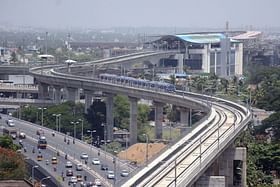The CMP identified three potential metro rail networks based on passengers per hour per direction (PPHPD) data collected, with projections made up to 2042.
Trichy Corporation has identified three high-demand corridors for a proposed metro rail network as part of its Comprehensive Mobility Plan (CMP).
The mobility plan created with the help of a consultant based in Bengaluru— aims to serve as a long-term vision document to strengthen public transport infrastructure and non-motorised modes in the city.
The identified corridors, spanning 68 km in total, may serve as a masterplan for the proposed Trichy metro proposed by the Chennai Metro Rail Limited (CMRL), reports Times of India.
The plan has been prepared based on 20 data collection types and surveys conducted in an area of 803 sq. km.
The consultants analysed a population of 14.7 lakh by studying all 65 wards in the city, Lalgudi and Thuvakudi municipalities, and four town panchayats.
It identified three potential metro rail networks based on passengers per hour per direction (PPHPD) data collected, with projections made up to 2042.
As per the proposed corridors, route one covers 18.7 km, connecting Samayapuram in the northern suburbs, with Vayalur in the west after passing through Srirangam and Thillai Nagar.
Route two, which will be the longest, spanning 26 km, links Thuvakudi with Panjapur through the Central bus stand.
Route three will run for 23.3 km to connect Trichy railway junction to Panjapur, passing through the international airport and semi-ring road.
The network of the three corridors will integrate at proposed intersections including the Central bus stand, railway junction, and Panchapur IBT.
According to the consultants, the corridors will be executed in phases and the type of metro network — Metro Lite or Metro Neo — will be designed based on the city’s passenger capacity, reports TOI.
Trichy Corporation said that an alternative analysis report will be prepared which can serve as a base document for preparing the detailed project report (DPR) for the Trichy metro project.
Furthermore, the CMP report aims to increase urban public transport’s share from 22 per cent (as of 2022) to 40 per cent by 2042.
It proposes short, medium, and long-term strategies that promote sustainable urban transportation.
The report additionally recommended a 4 km shared bicycle project and 11 km of dedicated cycle tracks, for which several bus stands and academic institutions in the city were also identified.


